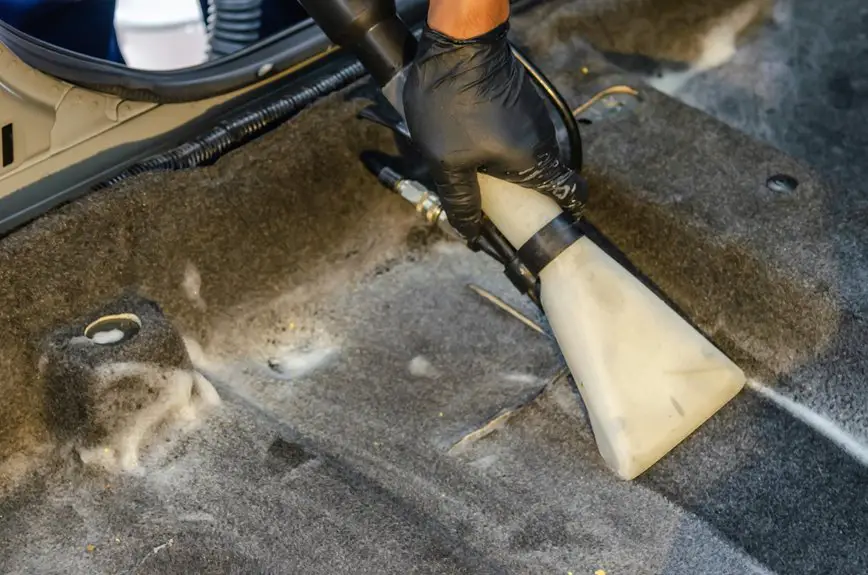You shouldn’t use carpet cleaner on your upholstery because it often contains stronger chemicals that can damage the fabric, cause discoloration, and leave residue attracting more dirt. Upholstery is softer and more delicate, needing gentler cleaners tailored for its fibers. Before trying any cleaner, always test it on a hidden spot to avoid costly mistakes. If you want to keep your furniture looking great and learn safer cleaning options, there’s plenty more useful guidance ahead.
Table of Contents
Key Takeaways
- Carpet cleaners are generally too harsh for upholstery and can cause fabric damage, discoloration, or residue buildup.
- Upholstery requires gentler, fabric-specific cleaners that protect softness and prevent shrinking or warping.
- Always test any cleaner, including carpet products, on a hidden upholstery spot before full use to check for damage.
- Natural alternatives like vinegar-water solutions or baking soda are safer for routine upholstery stain removal and odor control.
- For tough stains or delicate fabrics, professional upholstery cleaning is recommended to avoid irreversible damage.
Understanding the Differences Between Carpet and Upholstery Fabrics
Although carpet and upholstery fabrics might look similar at first glance, they’ve distinct characteristics that affect how you should clean them.
Carpet fibers are typically denser and designed to withstand heavy foot traffic, so they’re more durable and can tolerate stronger cleaning methods.
Carpet fibers are dense and durable, built to endure heavy use and tougher cleaning techniques.
Upholstery fabrics, on the other hand, are usually softer and thinner, meant for comfort rather than durability. You’ll find various materials like cotton, velvet, or leather in upholstery, each requiring specific care.
Plus, upholstery often includes padding underneath, making it sensitive to moisture and harsh chemicals.
When cleaning, you need to take into account these differences carefully. Using a product or method suited for carpet might damage your upholstery, causing discoloration, shrinkage, or fabric weakening.
Always check fabric type and manufacturer guidelines before proceeding.
Common Ingredients in Carpet Cleaners vs. Upholstery Cleaners
Cleaning products for carpets and upholstery contain different ingredients tailored to their specific fabrics and uses.
Carpet cleaners often include stronger surfactants and enzymes designed to break down tough dirt, oils, and pet stains embedded deep in carpet fibers. They may also contain optical brighteners to enhance color vibrancy.
Upholstery cleaners, however, typically feature gentler detergents and fabric softeners to protect delicate materials like velvet, leather, or microfiber. They focus on removing surface stains without damaging the fabric’s texture or color.
You’ll also find that upholstery products often contain ingredients that help prevent residue buildup, which can attract more dirt over time.
Understanding these differences helps you choose the right cleaner and keep your furniture looking fresh without risking damage.
Potential Risks of Using Carpet Cleaner on Upholstery
If you use carpet cleaner on your upholstery, you risk damaging the fabric’s fibers and colors.
Carpet cleaners often contain stronger chemicals designed for dense, durable carpets, which can be too harsh for delicate upholstery materials. This might lead to discoloration, fading, or even fabric weakening.
Additionally, these cleaners can leave behind residues that attract dirt faster, making your upholstery look dirtier over time.
Using carpet cleaner improperly may also cause shrinkage or warping if the fabric absorbs too much moisture.
Since upholstery fabrics vary widely, what works on one type could ruin another.
To avoid costly damage, it’s important to understand these risks before applying carpet cleaner on your furniture.
Your best bet is to choose products specifically made for upholstery or consult care instructions.
How to Test Carpet Cleaner on Upholstery Safely
Before applying carpet cleaner to your upholstery, you should always test it in a small, hidden area to avoid unexpected damage. Here’s how to do it safely: dampen a white cloth with the cleaner and gently blot the test spot. Wait 10-15 minutes, then check for discoloration, fabric distortion, or residue. If all looks good, you can proceed with cleaning the entire piece.
| Step | Action | What to Look For |
|---|---|---|
| 1. Prepare | Dampen cloth with cleaner | No excessive wetness |
| 2. Apply | Blot hidden spot gently | No color change or fading |
| 3. Wait & Inspect | Let dry 10-15 minutes | Fabric texture intact, no residue |
This simple test helps you avoid costly mistakes and keeps your upholstery safe.
Types of Upholstery That Are More Sensitive to Cleaning Products
Knowing how to test a carpet cleaner on upholstery helps protect your furniture, but some fabrics still require extra caution.
Delicate materials like silk, velvet, and linen can easily get damaged or stained by harsh chemicals. Leather and suede also need special care since many carpet cleaners can strip their natural oils, causing dryness or discoloration.
When dealing with antique or handmade upholstery, you should be extra careful because these fabrics often have unique dyes or finishes that react poorly to standard cleaners.
If your upholstery falls into any of these categories, avoid using regular carpet cleaners without confirming their safety first. Instead, consider specialized products designed for delicate or natural fibers to keep your furniture looking its best without risking damage.
Step-by-Step Guide to Cleaning Upholstery Properly
Cleaning upholstery properly involves a few essential steps that guarantee your furniture stays fresh without damage.
Proper upholstery cleaning keeps your furniture fresh and protected from damage.
First, vacuum the surface thoroughly to remove dust and debris.
Next, test your cleaning solution on a hidden area to verify it won’t discolor or harm the fabric.
Then, apply the cleaner sparingly using a soft cloth or sponge, gently blotting stains instead of rubbing them.
After treating stains, use a damp cloth to remove any residue. Avoid soaking the fabric, as excess moisture can cause mold or damage.
Finally, let the upholstery air dry completely, preferably with good ventilation or a fan.
Following these steps helps maintain your furniture’s appearance and prolongs its life without risking damage from improper cleaning.
Alternatives to Carpet Cleaners for Upholstery Maintenance
You don’t always have to rely on carpet cleaners to keep your upholstery fresh.
Gentle fabric cleaning options, like mild detergents or specialized sprays, can be effective without damaging your furniture.
You can also try homemade solutions using common household ingredients to maintain your upholstery safely and affordably.
Gentle Fabric Cleaning Options
Someone who cares about preserving the look and feel of their upholstery will want to explore gentle fabric cleaning options that avoid harsh chemicals found in many carpet cleaners.
You can opt for mild detergent solutions specifically designed for delicate fabrics. These products often come with clear instructions, ensuring you won’t damage your furniture.
Another great choice is using upholstery-specific foams or sprays that lift dirt without soaking the fabric. You might also consider professional-grade fabric refreshers that neutralize odors gently.
When using any cleaner, always test it on a small, hidden area first to check for colorfastness.
Homemade Upholstery Solutions
While commercial carpet cleaners can be effective, homemade upholstery solutions offer a gentle and affordable alternative for maintaining your furniture.
You can easily whip up these safe cleaners with common household ingredients that won’t harm your upholstery fabric. Here are some simple options to try:
- Mix equal parts white vinegar and water to tackle stains and odors.
- Combine baking soda with a few drops of essential oil for a fresh, deodorizing powder.
- Use mild dish soap diluted in warm water for everyday spot cleaning.
- Create a paste with cornstarch and water to absorb grease and grime.
These DIY solutions let you clean effectively without harsh chemicals, preserving your upholstery’s look and feel.
Plus, they’re easy to customize based on your fabric type and cleaning needs.
When Professional Upholstery Cleaning Is the Best Option
Although many upholstery stains respond well to DIY cleaning methods, certain situations call for professional upholstery cleaning services. If your furniture has persistent stains, deep-seated dirt, or odors that DIY cleaners can’t remove, professionals have the tools and expertise to tackle these issues effectively.
You should also consider professional cleaning if your upholstery is delicate, antique, or made from materials that can easily get damaged by harsh chemicals or improper cleaning techniques. Additionally, large pieces or extensive coverage can be overwhelming to clean on your own, making professional services a practical choice.
Hiring experts guarantees thorough cleaning without risking damage, extending your upholstery’s life and keeping it looking its best. When in doubt, opting for professional help is a smart decision.
Tips for Preventing Stains and Damage to Upholstery
If you want your upholstery to stay fresh and durable, taking preventive measures is key. You can protect your furniture from stains and damage by following simple habits that save you time and money later.
Here are some effective tips:
- Use slipcovers or throws in high-traffic areas to shield fabric.
- Avoid eating or drinking on upholstered pieces to prevent spills.
- Keep pets off the furniture or use pet-friendly blankets.
- Regularly vacuum upholstery to remove dust and dirt that wear down fibers.
How to Remove Common Upholstery Stains Without Carpet Cleaner
You don’t always need a carpet cleaner to tackle upholstery stains.
Simple natural remedies and DIY tips can work wonders on common spills.
Let’s explore some effective stain removal solutions you can try at home.
Natural Stain Removal Methods
When dealing with stains on your upholstery, you don’t always need a carpet cleaner to get the job done. Natural stain removal methods often work just as well and are gentler on your fabric.
You can tackle common stains using simple household ingredients. For example:
- Baking soda: Sprinkle on the stain, let it sit, then vacuum to absorb odors and loosen dirt.
- White vinegar: Mix with water and blot stains to break down grime and freshen fabric.
- Lemon juice: Apply to brighten and lift stains, especially rust or mildew spots.
- Club soda: Blot spills immediately to prevent setting, thanks to its carbonation and mild acidity.
These natural options can save you time and money while protecting your upholstery’s integrity.
DIY Upholstery Cleaning Tips
Natural stain removers offer a great starting point, but some stubborn upholstery stains call for a bit more care.
To tackle common spots, start by blotting spills immediately with a clean cloth to prevent setting. For greasy stains, sprinkle baking soda on the area, let it sit for 15 minutes, then vacuum it up.
Use a mixture of mild dish soap and warm water to gently scrub fabric stains; apply with a soft brush or cloth and rinse with a damp cloth. Avoid soaking the upholstery to prevent damage.
For pet stains, a vinegar and water solution helps neutralize odors.
Always test any cleaning method on an inconspicuous spot first to ascertain it won’t discolor or harm your fabric. These simple tips can keep your upholstery fresh without carpet cleaner.
Effective Stain Treatment Solutions
Three simple household ingredients can tackle most common upholstery stains effectively without the need for carpet cleaner.
You don’t have to rely on harsh chemicals to get your furniture looking fresh again. Instead, try these easy solutions tailored to specific stains:
- Baking soda and vinegar: Great for removing odors and light stains; sprinkle baking soda, spray vinegar, then blot.
- Dish soap and water: Perfect for food and drink spills; mix a few drops with warm water and gently dab the stain.
- Hydrogen peroxide: Effective on blood stains; apply cautiously to avoid discoloration.
- Rubbing alcohol: Works well on ink or dye stains; dab gently with a cloth soaked in alcohol.
Using these methods, you can clean your upholstery safely and efficiently without risking damage from carpet cleaners.
Frequently Asked Questions
Can Carpet Cleaners Cause Color Fading on Upholstery?
Did you know 30% of upholstery owners report color fading after cleaning? Yes, carpet cleaners can cause fading if they’re too harsh or not meant for fabric. Always test a small area first to protect your furniture.
Are Carpet Cleaners Safe for Leather Upholstery?
You shouldn’t use carpet cleaners on leather upholstery because they can damage the material. Instead, choose products specifically designed for leather to keep it safe and conditioned. Always test a small area first to avoid issues.
How Often Should Upholstery Be Professionally Cleaned?
Think of your upholstery as a silent witness to daily life—it deserves a deep cleanse at least once a year. If you’ve got pets or kids, you’ll want to clean it more often to keep it fresh.
Can Using Carpet Cleaner Void Upholstery Warranties?
Yes, using carpet cleaner can void your upholstery warranty if the product isn’t approved by the manufacturer. Always check your warranty terms and use recommended cleaning methods to avoid any issues with coverage or damage claims.
What Household Items Can Replace Carpet Cleaners for Upholstery?
Did you know 60% of people prefer natural cleaners? You can replace carpet cleaners with a mix of vinegar, water, and dish soap for upholstery. It’s safe, effective, and won’t risk damaging your fabric or voiding warranties.
- How to Clean a Leather Sofa: A Step-by-Step Guide - July 8, 2025
- The Ultimate Guide to Cleaning a Leather Sofa - July 8, 2025
- Is an Upholstery Business Profitable? A Look at Costs and Earnings - July 8, 2025





